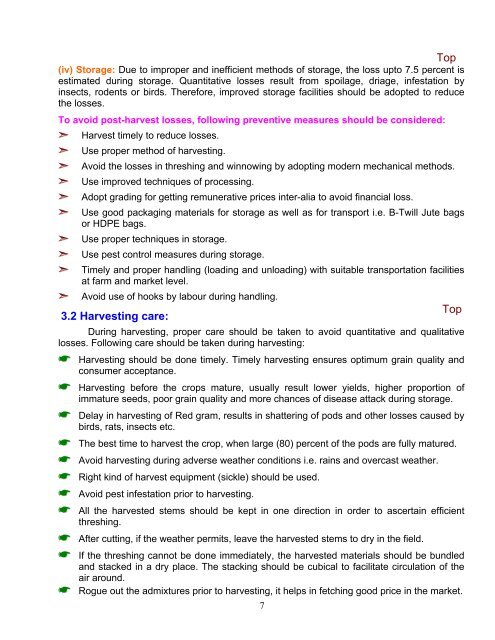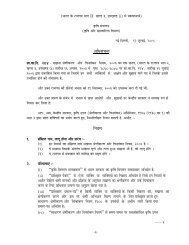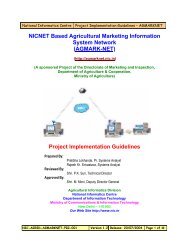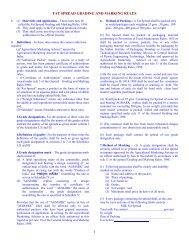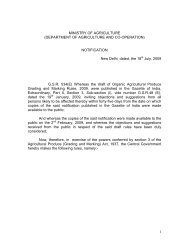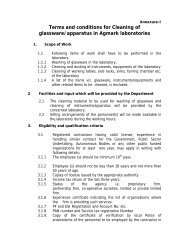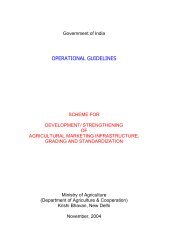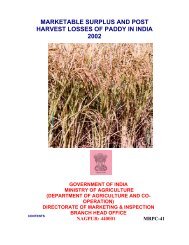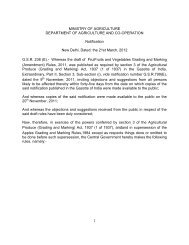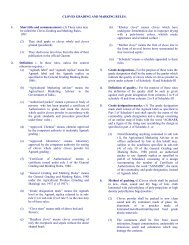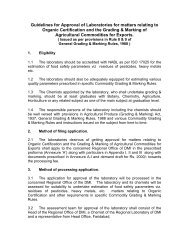Post-harvest profile of red gram - Agmarknet
Post-harvest profile of red gram - Agmarknet
Post-harvest profile of red gram - Agmarknet
Create successful ePaper yourself
Turn your PDF publications into a flip-book with our unique Google optimized e-Paper software.
(iv) Storage: Due to improper and inefficient methods <strong>of</strong> storage, the loss upto 7.5 percent isestimated during storage. Quantitative losses result from spoilage, driage, infestation byinsects, rodents or birds. Therefore, improved storage facilities should be adopted to <strong>red</strong>ucethe losses.To avoid post-<strong>harvest</strong> losses, following preventive measures should be conside<strong>red</strong>:➣ Harvest timely to <strong>red</strong>uce losses.➣ Use proper method <strong>of</strong> <strong>harvest</strong>ing.➣ Avoid the losses in threshing and winnowing by adopting modern mechanical methods.➣ Use improved techniques <strong>of</strong> processing.➣ Adopt grading for getting remunerative prices inter-alia to avoid financial loss.➣ Use good packaging materials for storage as well as for transport i.e. B-Twill Jute bagsor HDPE bags.➣ Use proper techniques in storage.➣ Use pest control measures during storage.➣Timely and proper handling (loading and unloading) with suitable transportation facilitiesat farm and market level.➣ Avoid use <strong>of</strong> hooks by labour during handling.3.2 Harvesting care:During <strong>harvest</strong>ing, proper care should be taken to avoid quantitative and qualitativelosses. Following care should be taken during <strong>harvest</strong>ing:☛ Harvesting should be done timely. Timely <strong>harvest</strong>ing ensures optimum grain quality andconsumer acceptance.☛☛☛☛☛☛☛☛☛Harvesting before the crops mature, usually result lower yields, higher proportion <strong>of</strong>immature seeds, poor grain quality and more chances <strong>of</strong> disease attack during storage.Delay in <strong>harvest</strong>ing <strong>of</strong> Red <strong>gram</strong>, results in shattering <strong>of</strong> pods and other losses caused bybirds, rats, insects etc.The best time to <strong>harvest</strong> the crop, when large (80) percent <strong>of</strong> the pods are fully matu<strong>red</strong>.Avoid <strong>harvest</strong>ing during adverse weather conditions i.e. rains and overcast weather.☛ Right kind <strong>of</strong> <strong>harvest</strong> equipment (sickle) should be used.Avoid pest infestation prior to <strong>harvest</strong>ing.All the <strong>harvest</strong>ed stems should be kept in one direction in order to ascertain efficientthreshing.After cutting, if the weather permits, leave the <strong>harvest</strong>ed stems to dry in the field.If the threshing cannot be done immediately, the <strong>harvest</strong>ed materials should be bundledand stacked in a dry place. The stacking should be cubical to facilitate circulation <strong>of</strong> theair around.☛ Rogue out the admixtures prior to <strong>harvest</strong>ing, it helps in fetching good price in the market.7


